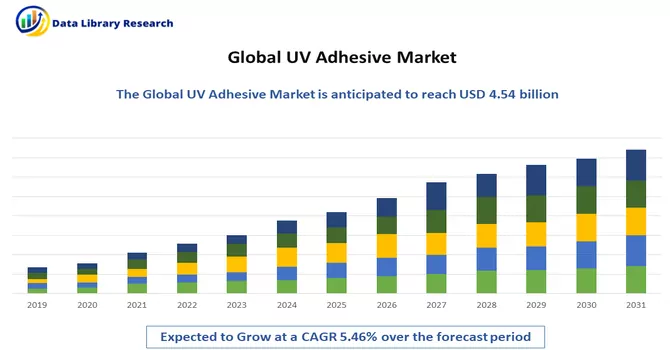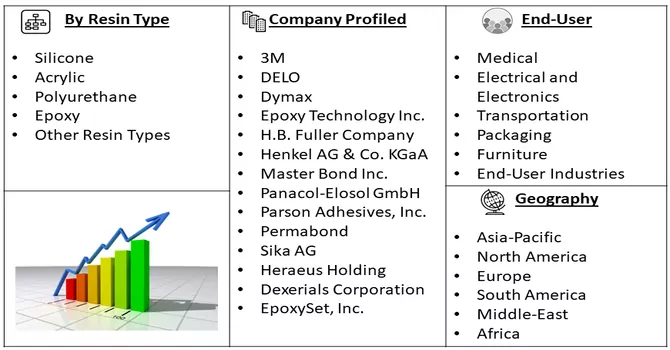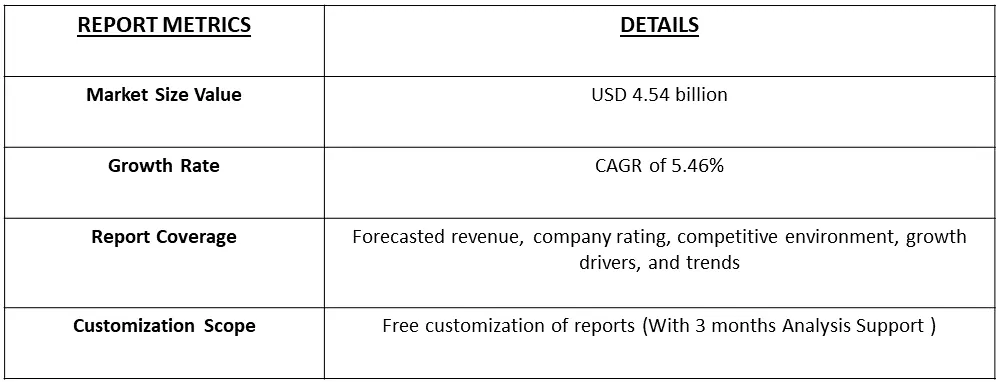Anticipated to undergo substantial growth, the UV-curable adhesives Market is projected to increase from USD 4.54 billion in 2023. This forecast reflects a Compound Annual Growth Rate (CAGR) of 5.46% over the forecast period spanning from 2023 to 2030. The expected expansion in market size signifies a positive trajectory for the UV-curable adhesives industry during this period.

Get Complete Analysis Of The Report - Download Free Sample PDF
UV adhesive, or ultraviolet adhesive, refers to a type of adhesive that cures and solidifies when exposed to ultraviolet (UV) light. This curing process is initiated by the presence of UV radiation, typically emitted from a UV light source. UV adhesives are widely used in various industries due to their rapid curing capabilities and ability to bond materials such as glass, plastic, metal, and composites. The key components of UV adhesives include monomers, oligomers, and photoinitiators. When exposed to UV light, the photoinitiators in the adhesive undergo a photochemical reaction, initiating the polymerization of the monomers and oligomers. This reaction transforms the liquid adhesive into a solid state, creating a strong bond between the adhered surfaces.
Government support for research and development activities, coupled with industry investments in innovation, contributes to the growth of the UV adhesive market. Initiatives aimed at technological advancements and product development enhance the market landscape. Moreover, the packaging industry's need for fast-curing adhesives to enhance production efficiency drives the demand for UV adhesives. These adhesives find applications in bonding and sealing processes in the packaging of consumer goods, food, and pharmaceuticals.
The market's growing demand for compact and high-performance electronic devices, coupled with the trend toward miniaturization, creates opportunities for UV adhesives. These adhesives facilitate precise and rapid bonding in semiconductor and electronics assembly. Moreover, with the expanding market for displays, LED lighting, and optical components, UV adhesives find applications in bonding and assembly processes. Opportunities arise in the production of high-resolution displays, cameras, sensors, and optical devices. Furthermore, ongoing research and development in UV technology, including UV LED-curable adhesives and advancements in curing equipment, present opportunities for manufacturers to introduce innovative and high-performance UV adhesive products. Also, the growing demand for medical devices opens opportunities for UV adhesives in the assembly and bonding of healthcare equipment. UV adhesives can be designed to meet the stringent requirements of the medical industry, including biocompatibility and sterilization compatibility.
Market Segmentation: The UV-curable adhesives Market is Segmented by Resin Type (Silicone, Acrylic, Polyurethane, Epoxy, and Other Resin Types), End-User Industry (Medical, Electrical and Electronics, Transportation, Packaging, Furniture, and Other End-User Industries), and Geography (Asia-Pacific, North America, Europe, and Middle-East & Africa). The Market Sizes and Forecasts for the UV-Curable Adhesives Market are Provided based on Value (USD Million) for all The Above Segments.

For Detailed Market Segmentation - Download Free Sample PDF
Market Drivers:
Growing Production of ICs and Semiconductors
The production of integrated circuits (ICs) and semiconductors is a highly intricate and precise process that involves various critical steps, such as the bonding of semiconductor wafers, assembly of microchips, and encapsulation. UV adhesives play a crucial role in these processes, contributing to the reliable and efficient bonding of semiconductor components. The latest news report from October 2023 highlights a significant increase of 285.3% in South Korea's semiconductor and display equipment inventory. While the global Information and Communication Technology (ICT) market may be stagnating, this surge in semiconductor equipment indicates a noteworthy development. The increase in semiconductor equipment suggests a potential surge in semiconductor production activities in the region. This upswing in semiconductor manufacturing could lead to a subsequent increase in the demand for UV adhesives. As the semiconductor industry expands, the reliance on UV adhesives for precise and efficient bonding in various production stages is likely to grow. The critical role of UV adhesives in semiconductor manufacturing positions them as a key contributor to the growth of the overall UV adhesive market. This interplay underscores the interconnected nature of industry trends, market dynamics, and technological advancements, all of which collectively influence the growth trajectory of the UV adhesive market.
Increasing Demand Due to Favourable Environmental Regulation
The increasing demand for UV adhesives is notably influenced by the implementation of favourable environmental regulations across various industries. As regulatory bodies worldwide emphasize the reduction of volatile organic compounds (VOCs) and the adoption of eco-friendly practices, UV adhesives have emerged as a preferred choice, aligning with these sustainability goals. The electronics and medical device industries, which are subject to stringent regulations, have embraced UV adhesives for their low VOC emissions and rapid curing properties. This is particularly critical in the assembly of sensitive electronic and medical components. UV adhesives are gaining traction in the construction sector, especially in applications such as glass bonding and facade assembly. The reduced environmental impact aligns with green building standards and certifications Thus, the market is expected to witness significant growth over the forecast period.
Market Restraints
High Equipment Cost
The adoption of UV adhesive technology requires the installation of UV curing equipment, which can involve high upfront costs. UV curing systems, including UV lamps and associated machinery, can be expensive to purchase and install. This initial investment can pose a barrier, especially for small and medium-sized enterprises (SMEs) or businesses with limited capital budgets. Additionally, the need for proper maintenance and periodic replacement of UV lamps can contribute to ongoing operational expenses. This financial aspect can be a significant factor influencing the decision-making process for businesses considering the transition to UV adhesives.
The global lockdowns and restrictions imposed to curb the spread of the virus disrupted supply chains, affecting the production and distribution of raw materials and UV adhesive products. Delays in transportation and logistics hindered the timely delivery of components, impacting the availability of UV adhesives. Many end-user industries, including automotive, construction, and electronics, experienced a slowdown in operations during the pandemic. This reduced manufacturing activities and, consequently, the demand for UV adhesives used in assembly and bonding processes. The pandemic underscored the importance of sustainability and eco-friendly practices. This emphasis could potentially drive demand for UV adhesives in the long term, given their environmentally friendly characteristics. Thus, the COVID-19 impact on the UV adhesive market is complex and varies across industries. While certain challenges arose, opportunities for growth and innovation also emerged as businesses navigated the changing landscape during and post the pandemic.
Segmental Analysis:
Silicone Resin Type Segment is Expected to Witness Significant growth Over the Forecast Period
The construction industry, a significant consumer of silicone resins for sealants and coatings, experienced disruptions due to lockdowns and labour shortages. This led to a slowdown in construction activities, affecting the demand for silicone resins in certain applications. The automotive sector, which utilizes silicone resins for various applications such as adhesives and coatings, faced challenges. Production halts, supply chain disruptions, and a shift in consumer priorities contributed to a temporary decline in demand for automotive-related silicone resin products. Silicone resins found to increase demand in healthcare applications, particularly for medical devices and equipment. The need for reliable and durable materials in the healthcare sector drove demand for silicone resin-based products. Thus, the segment is expected to witness significant growth over the forecast period.
Electrical and Electronics Segment is Expected to Witness Significant Growth Over the Forecast Period
The electronic segment is a key industry that extensively utilizes UV adhesives due to their unique properties and advantages. UV adhesives have become an indispensable component in the manufacturing processes of electronic devices, contributing to enhanced performance, reliability, and efficiency. Electronics manufacturing requires precise bonding of components, and UV adhesives offer a solution that meets this demand. These adhesives cure rapidly upon exposure to UV light, allowing for quick and accurate assembly of intricate electronic components. The increasing demand for consumer electronics, including smartphones, tablets, and wearables, has driven the adoption of UV adhesives. These adhesives contribute to the miniaturization of electronic components and the production of compact and lightweight devices. Thus, owing to such benefits the segment is expected to witness significant growth over the forecast period.
Asia-Pacific Region is Expected to Witness Significant Growth Over the Forecast Period
The Asia-Pacific region is poised to be the dominant force in the global UV-curable adhesives market, driven by significant investments in the packaging and medical industries, as well as the burgeoning electrical and electronics production in countries like China, India, and Japan. The increased adoption of UV-curable adhesives in the region is a testament to the expanding industrial landscape and the growing demand for advanced adhesive solutions. Moreover, industry players, such as the South Korea-based SONGWON Industrial Group, are actively contributing to the growth of the UV-curable adhesives market. SONGWON's expansion of its coatings portfolio, unveiling new UV absorbers and blends, reflects the commitment to high-performance UV systems, driving advancements in the industry. China stands out as the world's largest consumer of packaging materials, attributed to the growing per capita income and the influence of thriving e-commerce giants. The packaging industry in India, the fifth-largest globally, is experiencing substantial growth, providing a significant market for UV-curable adhesives. The outlook for the UV-curable adhesives market in the Asia-Pacific region remains positive, driven by ongoing industrialization, rising consumer demand, and continuous innovations by key players. As the packaging, medical, and electronics industries continue to expand, the adoption of UV-curable adhesives is expected to grow, consolidating the region's dominance in the global market. The strategic focus on high-performance UV systems and the development of user-friendly blends further contribute to the market's upward trajectory.

Get Complete Analysis Of The Report - Download Free Sample PDF
The UV-curable adhesives market exhibits consolidation, with a limited number of key players holding substantial market share. In this scenario, a select few companies play a prominent role in fulfilling a significant portion of the overall market demand. This consolidation implies that the market is characterized by a notable concentration of influence among these major players, contributing to a landscape where their actions and strategies significantly impact the dynamics of the UV-curable adhesives industry. The consolidated nature of the market often results in intensified competition among these key players and may influence the overall direction and trends within the UV-curable adhesives sector. Some of the Key Market Players working in this Segment
Recent Development:
1) April 2023: Dymax Corporation announced the development of UV/LED curable adhesive, i.e., 1045-M adhesive. This adhesive will be used in medical line assembly applications.
2) March 2022: DELO Industrial Adhesives announced the development of DELO PHOTOBOND UV acrylates for optoelectronics. This move will increase the company's product portfolio in emerging technologies applications.
Q1. What is the Growth Rate of the UV Adhesive Market ?
UV Adhesive Market is expected to reach at a Compound Annual Growth Rate (CAGR) of 5.46% over the forecast period.
Q2. What are the factors driving the UV Adhesive Market ?
Key factors that are driving the growth include the Growing Production of ICs and Semiconductors and Increasing Demand Due to Favourable Environmental Regulation.
Q3. Who are the key players in UV Adhesive Market ?
Some key players operating in the market include
Q4. Which Region is expected to hold the highest Market share?
Asia-pacific region is expected to hold the highest Market share.
Data Library Research are conducted by industry experts who offer insight on industry structure, market segmentations technology assessment and competitive landscape (CL), and penetration, as well as on emerging trends. Their analysis is based on primary interviews (~ 80%) and secondary research (~ 20%) as well as years of professional expertise in their respective industries. Adding to this, by analysing historical trends and current market positions, our analysts predict where the market will be headed for the next five years. Furthermore, the varying trends of segment & categories geographically presented are also studied and the estimated based on the primary & secondary research.
In this particular report from the supply side Data Library Research has conducted primary surveys (interviews) with the key level executives (VP, CEO’s, Marketing Director, Business Development Manager and SOFT) of the companies that active & prominent as well as the midsized organization
FIGURE 1: DLR RESEARH PROCESS

Extensive primary research was conducted to gain a deeper insight of the market and industry performance. The analysis is based on both primary and secondary research as well as years of professional expertise in the respective industries.
In addition to analysing current and historical trends, our analysts predict where the market is headed over the next five years.
It varies by segment for these categories geographically presented in the list of market tables. Speaking about this particular report we have conducted primary surveys (interviews) with the key level executives (VP, CEO’s, Marketing Director, Business Development Manager and many more) of the major players active in the market.
Secondary ResearchSecondary research was mainly used to collect and identify information useful for the extensive, technical, market-oriented, and Friend’s study of the Global Extra Neutral Alcohol. It was also used to obtain key information about major players, market classification and segmentation according to the industry trends, geographical markets, and developments related to the market and technology perspectives. For this study, analysts have gathered information from various credible sources, such as annual reports, sec filings, journals, white papers, SOFT presentations, and company web sites.
Market Size EstimationBoth, top-down and bottom-up approaches were used to estimate and validate the size of the Global market and to estimate the size of various other dependent submarkets in the overall Extra Neutral Alcohol. The key players in the market were identified through secondary research and their market contributions in the respective geographies were determined through primary and secondary research.
Forecast Model
